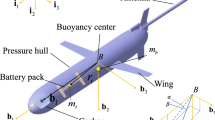Abstract
The mass configuration of the buoyancy-driven underwater glider is decomposed and defined. The coupling between the glider body and its internal masses is addressed using the energy law. A glider motion model is established, and the corresponding simulation program is derived using MATLAB. The characteristics of the glider motion are explored using this program. The simulation results show that the basic characteristic of a buoyancy-driven underwater glider is the periodic alternation of downward and upward motions. The glider’s spiral motion can be applied to missions in restricted regions. The glider’s horizontal velocity, gliding depth and its motion radius in spiral motion can be changed to meet different application purposes by using different glider parameter designs. The simulation also shows that the model is appropriate and the program has strong simulation functions.
Similar content being viewed by others
References
Henry, S., 1989. The Slocum mission. Oceanography, 2: 22–25.
Swallow, J. C., 1955. Neutral-buoyancy float for measuring deep currents. Deep-Sea Res., 3(1): 93–104.
Woolsey, C. A., and N. E. Leonard, 2002. Stabilizing underwater vehicle motion using internal rotors. Automatica, 38(12): 2053–2062.
Graver, J. G., and N. E. Leonard, 2001. Underwater glider dynamics and control. 12th International Symposium on Unmanned Untethered Submersible Technology, 1742–1710.
Leonard, N. E., and J. G. Graver, 2001. Model-based feedback control of autonomous underwater gliders. IEEE J. Oceanic Eng., Spec. Issue Autonomous Ocean Samp. Networks, 26(4): 633–645.
Graver, J. G., J. Liu, C. Woolsey, and N. E. Leonard, 1998. Design and analysis of an underwater vehicle for controlled gliding. Proc. 32nd Conference on Inf. Sci. & Syst., 801–806.
Zhang, Y. W., 1998. Torpedo Hull Design. NWPU Press, Xi’an, 42–81 (in Chinese).
Ogata, K., 1990. Modern Control Engineering. Prentice Hall, New Jersey, 126–237.
Sturgis, B. R., R. D. Robinett III, and S. A. Kerr, 1996. Moving mass trim control for aerospace vehicles. J. Guidance, Control, & Dynamics, 19(5):1064–1070.
Webb, C., P. J. Simonetti, and C. P. Jones, 2001. SLOCUM: An underwater glider propelled by environmental energy. IEEE J. Oceanic Eng., 26(4): 447–452.
Author information
Authors and Affiliations
Corresponding author
Rights and permissions
About this article
Cite this article
Kan, L., Zhang, Y., Fan, H. et al. MATLAB-based simulation of buoyancy-driven underwater glider motion. J. Ocean Univ. China 7, 113–118 (2008). https://doi.org/10.1007/s11802-008-0113-2
Received:
Accepted:
Issue Date:
DOI: https://doi.org/10.1007/s11802-008-0113-2




